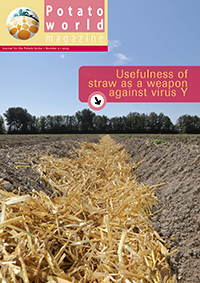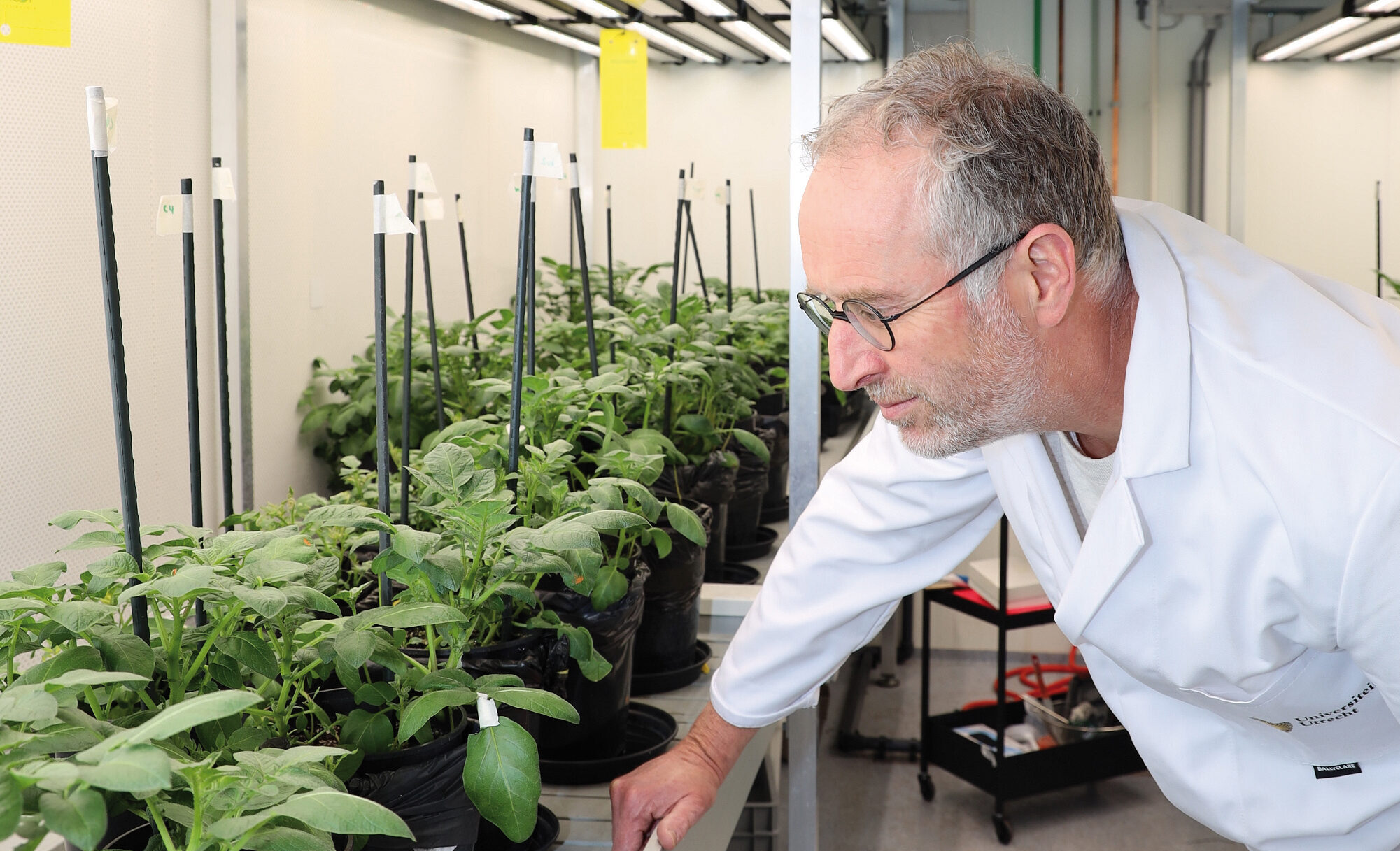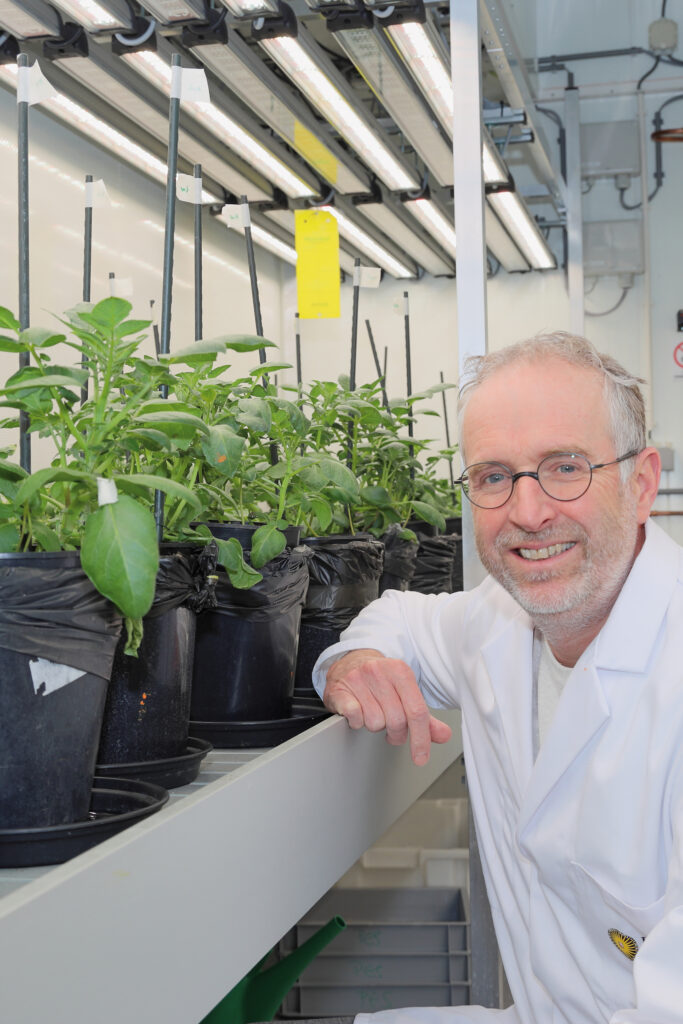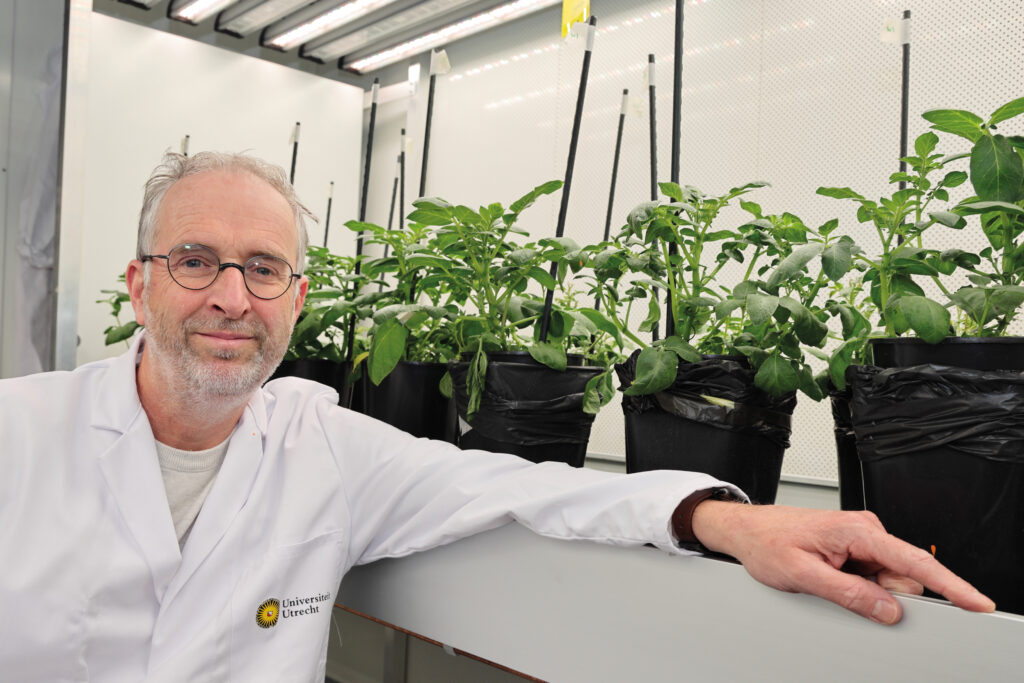Already a subscriber? Activate your premium account

Potatoworld Magazine

Climate change and the decreasing availability of crop protection chemicals and nitrogen are putting pressure on arable farming. Plants are having to grow under increasingly challenging conditions. The Dutch research project CropXR, in which the government is investing 43 million euros through the National Growth Fund (Nationaal Groeifonds), is therefore focusing on the faster development of extra resilient (eXtra Resilient) agricultural crops. ‘Understanding plant resilience is not an easy issue’, Prof. dr. Guido van den Ackerveken, Professor of Translational Plant Biology and programme leader of CropXR, sets the tone for the conversation. ‘Robust crops are extremely important, but they don’t always get enough attention in breeding at the moment’, he says.
‘With CropXR, we want to provide an innovative way to understand how resilience to environmental stress works. To gain that knowledge, we’re focusing on data science and the use of artificial intelligence (AI)’, the professor introduces the research. CropXR functions as a virtual institute that houses and facilitates research, on the basis of the ten-year PlantXR research programme. This is a so-called long-term programme, for which the Netherlands Organisation for Scientific Research (NWO) has reserved a budget. Participating knowledge institutions (Utrecht University, University of Amsterdam, Wageningen University & Research and Delft University of Technology) and partner companies also contribute to the funding.
‘Thanks to its long duration, the programme can work on complex research questions: what makes plants resilient to environmental stress, how do you properly map this out and how do you use this in breeding? We’ll combine this fundamental research programme with technological development. The focal point of the first half of the ten-year process is the methodology: how do you get the most meaningful information from measurement data, in order to improve our understanding of plant resilience? We can collect a lot of measurement data, but the bottleneck is converting this data into knowledge. The use of AI should provide a major breakthrough here: in smart ways that make much better use of that data. Subsequently, the developed methodology will be translated to the various crops that play a role within CropXR. Besides the potato, we also work on a number of vegetable crops such as tomatoes, lettuce, cabbages (Brassicas) and onions, and in floriculture we’ll work on the chrysanthemum.
‘Right now we have to investigate how we can breed that potato plant in such a way as to make it stronger. Resilient crops are extremely important and this has not always been the focus of attention in breeding. Of course, there are initiatives to breed robust potato varieties, but yield and quality are often seen as more important, as well as the right resistances to significant pathogens. Resilience has become a bit lost to view.’
‘We think it’s extremely important to include the potato in the whole. There are many issues in the potato sector, in which sustainability is extremely important’, says the programme leader, who immediately adds that the potato occupies an exceptional position. ‘In addition to a core programme focused on fundamental research, CropXR has developed crop-specific satellite programmes. We’re not going to work intensively on most crops until the second five years, but with the potato we’ll already be starting up seriously in the first year. Among other things with two large field trials, which will be set up in the next growing season. With these we’ll be mapping out resilience characteristics, such as how plants cope with stress factors. For another experiment, related to the microbiome of the potato, a group of researchers from Utrecht University will sample the roots of potato plants at various locations in the Netherlands. They’ll be mapping microbiomes, and then looking at their effect on potato growth and resilience in an experimental setting.

‘After completing their first phase, the HIP consortium was looking for a new round of research. We decided together to realise the second phase of that research programme in the first five years of CropXR’, the professor explains. HIP, which stands for Holland Innovative Potato, is a public-private research initiative of key players in the potato value chain and engages in precompetitive research. ‘The consortium is the industrial partner for potato projects within CropXR. Because HIP wants to start with their potato research already in the first phase, they cannot yet use the new technology and methodology that we’re developing at the same time. They’ll therefore approach the research from a different angle, for example with field trials. Ultimately, those two approaches will come together. That’s an interesting set-up that could turn out very well’, continued Van den Ackerveken. Dick Hylkema, Director of the Dutch Potato Organisation (NAO) who is closely involved with HIP, recently emphasised the importance of this merger from the platform of the annual members’ meeting of his organisation: ‘Holland Innovative Potato is working towards a sustainable, continuous supply of ware potatoes for the industry in the long term. That partnership will now become part of the CropXR institute, with money from the National Growth Fund. The invested euros will be doubled or even tripled and that’s something to be proud of’, says Hylkema.
‘I expect that by the end of the first five years we will have mapped out certain properties that could possibly be used in breeding. The potato breeding process that follows will take a very long time. There are methods, however, for example True Potato Seed (TPS), to accelerate breeding. It’s also possible that genome editing methods will be allowed in the meantime. That could speed things up, but our research doesn’t depend on that. We mainly just want to understand how properties work. We can then make crops resilient via a traditional breeding route or, if permitted, via other methods.’
’So far, when it comes to complex properties, breeding has mainly been a matter of trial and error. Producing many seedlings, testing them all, choosing the best and proceeding with them. Although you may not necessarily have the best-growing plant in that first selection, but rather a different one whose benefits will only be seen after two generations. For resilience in potatoes, the focus is mainly on environmental factors. If you know which properties you need to bring together in a variety, you can take very targeted breeding steps. Bringing different properties together does make the breeding process more complex. We have to find the right balance in this. But when it comes to very important resilience properties, it’s worth spending time on them. Ultimately, each breeding company will decide for itself what knowledge it takes on board and which parts will be used in their breeding processes.’
‘In the field trials we’ll include yield and quality aspects. In addition, we’ll study the balance between resilience and yield. If resilience comes at the expense of yield or quality, that’s a problem. We want to understand that trade-off, the adverse effects of some positive properties. In the end, it’s important, ideally, to have a resilient variety that also produces well. However, we need to get rid of the idea that it always has to be more. If a variety needs fewer plant protection chemicals or is better able to withstand weather extremes, fewer interventions are needed. That might result in some yield loss, but at least you still have a harvest, while a traditional crop might have many more problems from stress factors.’
‘The breeders must get to work to convert knowledge into new properties that must be reflected in their breeding portfolio. It will be quite a few years before those new potato varieties are in the fields. The step of transferring knowledge to a new variety just takes a lot of time. The use of markers in breeding was still in its infancy twenty years ago, but now it’s standard practice. We also hope that using AI and our data approach will eventually become standard methodology. This will make potato breeding much more efficient, targeted and predictable.’
‘They receive scientific reports from the various sub-projects once or twice a year. It‘s important that the scientists from both the breeding companies and the processing industries that are affiliated with the HIP consortium hear whatever knowledge is interesting for them to develop further. These users also have an interest in sustainable potato production. We have contact with the potato growers through BO Akkerbouw. This trade association is one of CropXR’s public partners. We use all these insights to make adjustments, so that the scientists can improve their research and keep a close eye on its translation into application.

‘No. It’s not a choice, that’s what makes this research so important. Just look at the Dutch and European directives. It’s almost impossible to achieve the goals of the Future Vision for Crop Protection 2030, and there’s still a lot to be done to comply with the European Green Deal and the Farm-to-Fork agenda. The Ministry of Agriculture, Nature and Food Quality (LNV) is therefore closely involved in our programme. When our proposal to the National Growth Fund was selected for further development, LNV supervised the process and submitted the proposal to the National Growth Fund. LNV will continue to be involved after the start, although they do not determine the terms of the content. The programme is very appealing to the officials concerned. It naturally ties in well with a number of policy agendas of the Ministry, such as circular agriculture and the Future Vision for Crop Protection 2030. Once all is going well, we hope to be recognised as an important institution on this subject and to set up collaborations with other initiatives in Europe as well. They do already exist, but often have a more traditionally approach to aspects of resilience. The focus on data makes CropXR unique and we’re seriously investing in that. The number of researchers working on the data side is significant.’
‘Then the potato will no longer have an exceptional position, but the crop will go along with the rest. We hope that we’ll then be able to start a renewed potato programme again, and that HIP will also participate in the second phase in order to use the technology that has been set up in phase 1.’ ●
Events
©2015 - 2024 Potatoworld | Webdesign and realisation COMMPRO